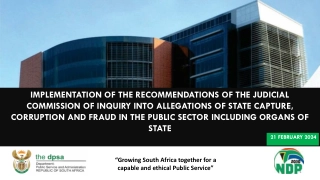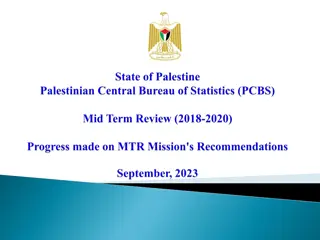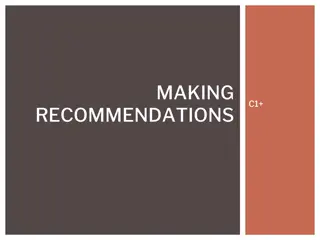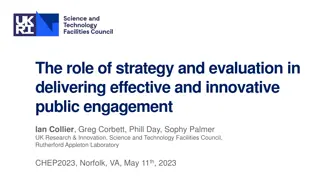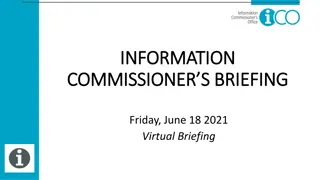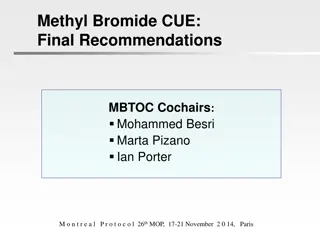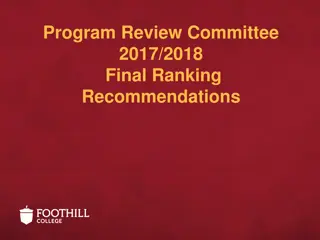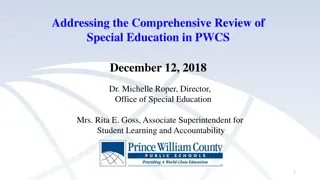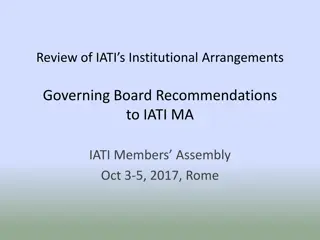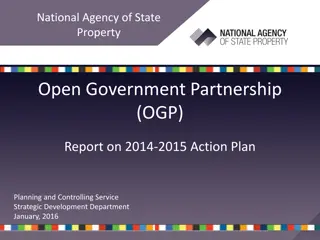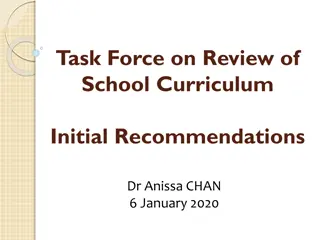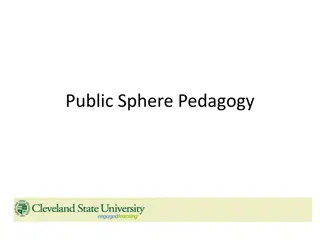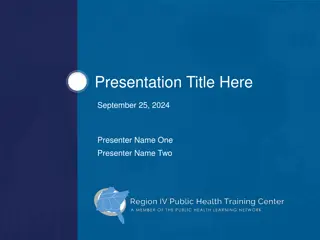GLAB Public Engagement Recommendations for GLRI APIV Development
GLAB, comprising of members Kyle Dreyfuss-Wells, Lisa Frede, Kay Nelson, Sylvia Orduo, Laura Rubin, and Jim Williams, provides recommendations for ensuring effective public input into the development of GLRI APIV. These recommendations focus on enhancing engagement with disadvantaged communities, leveraging previous input, improving outreach efforts, and utilizing diverse formats of engagement to ensure inclusivity and representation. The Board emphasizes the need for tailored approaches, meaningful interactions, and proactive measures to facilitate community involvement in the Great Lakes Basin's environmental initiatives.
Download Presentation

Please find below an Image/Link to download the presentation.
The content on the website is provided AS IS for your information and personal use only. It may not be sold, licensed, or shared on other websites without obtaining consent from the author. Download presentation by click this link. If you encounter any issues during the download, it is possible that the publisher has removed the file from their server.
E N D
Presentation Transcript
GLAB Charge Question Recommendations: Q s 1 and 2 Public Engagement Diversity, Equity, Inclusion, and Justice Great Lakes Advisory Board workgroup members: Kyle Dreyfuss-Wells, Chair Lisa Frede, Kay Nelson, Sylvia Ordu o, Laura Rubin, and Jim Williams
Charge question 1: Public engagement What does the Board recommend to ensure effective and representative public input into the development of GLRI APIV? (A) Should EPA and the regional work group (RWG) use a similar format of engagement as was done for GLRI APIII? (B) What specific steps could be taken to ensure we provide meaningful engagement with disadvantaged communities? (C) What groups and organizations could help EPA and the RWG conduct meaningful engagement with disadvantaged communities? (D) Many disadvantaged communities have already shared their priorities and perspectives to EPA and other agencies on a variety of environmental topics. How can we effectively incorporate and leverage this previous input? (E) There is a likely a lack of familiarity with the GLRI in many disadvantaged communities. What information and/or materials could be developed and shared beforehand to facilitate meaningful engagement?
Charge question 1: Public engagement GLAB recommendations (1 of 5) What does the Board recommend to ensure effective and representative public input into the development of GLRI APIV? (A) Should EPA and the RWG use a similar format of engagement as was done for GLRI APIII? No. GLAB appreciates efforts by the Great Lakes National Program Office (GLNPO) to improve effective and representative public input but more appears to be needed for greater outreach and inclusivity. GLNPO should provide a public report on its engagement efforts in GLRI APII and APIII, including locations, participation numbers, summary of concerns and feedback, local priorities, and the types of media or communication tools and networks used for public outreach; and what changes were implemented in response to previous GLAB recommendations. GLNPO should use different formats of engagement on GLRI APIV than were used for APIII to reach directly impacted residents and groups that have not typically participated in public input sessions.
Charge question 1: Public engagement GLAB recommendations (2 of 5) What does the Board recommend to ensure effective and representative public input into the development of GLRI APIV? (B) What specific steps could be taken to ensure we provide meaningful engagement with disadvantaged communities? Establish a new public engagement approach to AP IV that includes in-person meetings in every Area of Concern (AOC). Develop new formats of engagement (e.g., interviews, focus groups, testimonials) that focus on listening to community concerns and priorities regarding their experiences in the Great Lakes Basin. Do not expect members of disadvantaged communities to fit within predetermined GLRI AP input formats. Work with local groups and leaders in disadvantaged communities to discuss GLRI vocabulary and action plans ahead of public input sessions. Include resources for this preparatory engagement to ensure adequate local participation that relies on building relationships with communities.
Charge question 1: Public engagement GLAB recommendations (3 of 5) What does the Board recommend to ensure effective and representative public input into the development of GLRI APIV? (C) What groups and organizations could help EPA and the regional work group (RWG) conduct meaningful engagement with disadvantaged communities? Community groups that work on water quality, public health, and environmental justice (EJ) issues. Consult Region 5 EJ staff on contacts they have made and where they have built relationships with residents in disadvantaged communities. Environmental groups that work in watershed networks, land conservancies, and water quality advocates and non- profit organizations. Universities and colleges, including tribal and historically black institutions, with community-based relationships and initiatives that support local leadership and priorities.
Charge question 1: Public engagement GLAB recommendations (4 of 5) What does the Board recommend to ensure effective and representative public input into the development of GLRI APIV? (D) Many disadvantaged communities have already shared their priorities and perspectives to EPA and other agencies on a variety of environmental topics. How can we effectively incorporate and leverage this previous input? EPA/RWG staff should report in writing annually what they ve heard from disadvantaged communities and provide summaries at public meetings of what action steps have been taken and are in progress. AP public input organizers need to be clear and direct about the kind of input they are interested in receiving and how it will be used. The questions asked during these sessions need to articulate how they relate to and will be integrated into APIV. Staff on the ground that will be conducting these community meetings need to be educated to the issues in the communities and prepared to respond to non-AP specific concerns, i.e., direct them to appropriate agencies and add them to annual public input reports.
Charge question 1: Public engagement GLAB recommendations (5 of 5) What does the Board recommend to ensure effective and representative public input into the development of GLRI APIV? (E) There is a likely a lack of familiarity with the GLRI in many disadvantaged communities. What information and/or materials could be developed and shared beforehand to facilitate meaningful engagement? Prior to public engagement in a specific disadvantaged community, EPA should share a summary of what it has heard so far from said community and a summary of what has been discussed in other disadvantaged communities. The GLRI is a largely science-based endeavor that could benefit from more inclusive and accessible language in handouts and web pages for the general population to understand its applicability in their communities. Materials with clear and simple definitions of terminology and problems would be helpful, alongside visual examples of how GLRI has improved conditions in disadvantaged communities.
Charge question 2: Diversity, Equity, Inclusion, and Justice in GLRI APIV In the response to the previous set of charge questions, the GLAB made multiple references to include environmental justice into GLRI APIV. The GLAB provided some general examples about how environmental justice and/or diversity, equity, inclusion and justice could be considered into the implementation of the GLRI and future Action Plans. However, EPA and the RWG would like the GLAB s input on specific examples of how EJ could be best incorporated into GLRI APIV, especially given the level of detail of previous action plans. Please use GLRI APIII as a template when providing recommendations.
Charge question 2: Diversity, Equity, Inclusion, and Justice in GLRI APIV GLAB recommendations (1 of 3) How EJ could be best incorporated into GLRI APIV, especially given the level of detail of previous action plans. Please use GLRI APIII as a template when providing recommendations. For example, does the GLRI APIV include a brief description of Justice40 (and its relationship to GLRI) in the introduction and then reference how ongoing and future work will consider opportunities to benefit disadvantaged communities? In response to the example question, the GLAB suggests yes, in part. Plus, review and post on the GLRI website the Justice40 environmental justice initiatives for each RWG organization partnerfor a comprehensive presentation of GLRI partner initiatives and implementation. Moreover, we recommend the following: Begin with what the EPA Administratorsays about what is and how to do EJ engagement. Outline how the GLRI is implementing the EPA Strategic Plan regarding EJ goals and objectives.
Charge question 2: Diversity, Equity, Inclusion, and Justice in GLRI APIV GLAB recommendations (1 of 3, continued) How EJ could be best incorporated into GLRI APIV, especially given the level of detail of previous action plans. Please use GLRI APIII as a template when providing recommendations. Provide a GLRI response to the EPA Equity Action Plan, particularly barriers to equitable outcomes, planned actions to overcome the barriers, and how GLNPO and/or the RWG will track its progress for the five priority areas. Ensure GLNPO and RWG staff have participated in EPA EJ training initiatives. Determine a baseline awareness among staff and stakeholders of economic justice alongside environmental justice goals within historically underserved communities. Prepare to review upcoming updates to an EPA Public Engagement document being worked on now through an internal workgroup. Consult OEJ-ECR leadership for more info. Outline GLRI s Justice40 goals and objectives. Develop an EJ glossary specific to its relevance for GLRI programs and partners. Conduct public engagement as an annual goal of the GLNPO rather than just around the Action Plan updates.
Charge question 2: Diversity, Equity, Inclusion, and Justice in GLRI APIV GLAB recommendations (2 of 3) How EJ could be best incorporated into GLRI APIV, especially given the level of detail of previous action plans. Please use GLRI APIII as a template when providing recommendations. In the GLAB s review of the Healing Our Waters-Great Lakes Coalition s (HOW-GLC) recommendations for GLRI APIV improvements based on APIII, we strongly support their overall list across the five focus areas. Additionally, the GLAB provides additional recommendations for stronger and specific actions to improve APIV s outcomes, outputs, and benefits toward improving diversity, equity, inclusion, and justice objectives. They include: Focus Area 1: Toxic Substances and Areas of Concern Providing guidance to states for the development of diverse public advisory councils (PAC). Developing opportunities for impacted community members remediation and beneficial use projects, particularly in equitable terms when alongside other stakeholder priorities.
Charge question 2: Diversity, Equity, Inclusion, and Justice in GLRI APIV GLAB recommendations (2 of 3, continued) How EJ could be best incorporated into GLRI APIV, especially given the level of detail of previous action plans. Please use GLRI APIII as a template when providing recommendations. Focus Area 2: Invasive Species Developing and enhancing measures to conduct outreach in disproportionately impacted communities. Integrating Traditional Ecological Knowledge (TEK) measures in technology and methodologies to refine techniques based on tribal and indigenous practices and history. Focus Area 3: Nearshore Health and Resilience Establishing collaboratives to connect upstream and downstream communities particularly among residents in vulnerable areas. Working with existing programs and identify new opportunities for watershed-based water quality measures in EJ communities. Supporting innovative approaches and projects to meet water quality measures of progress among non-traditional partners.
Charge question 2: Diversity, Equity, Inclusion, and Justice in GLRI APIV GLAB recommendations (2 of 3, cont. ) How EJ could be best incorporated into GLRI APIV, especially given the level of detail of previous action plans. Please use GLRI APIII as a template when providing recommendations. Focus Area 4: Habitat Restoration and Native Species Identifying climate warming protections in national forest and state and municipal lands for riparian canopy restoration to offset warming waterways and cold water fisheries, with deliberate consideration of EJ communities. Improving habitat resilience goals and objectives for tributary waterways for habitat and species diversity that includes disadvantaged community health and well-being. Working with EJ communities and community researchers to identify areas in lakes for interdisciplinary research and adaptive management to improve offshore native fishing populations and safe fishing consumption. Partnering with groups in historically underserved communities to educate and develop quantifiable targets for offshore phosphorous concentrations that support and sustain healthy plankton and fish populations and growth.
Charge question 2: Diversity, Equity, Inclusion, and Justice in GLRI APIV GLAB recommendations (2 of 3, cont.) How EJ could be best incorporated into GLRI APIV, especially given the level of detail of previous action plans. Please use GLRI APIII as a template when providing recommendations. Focus Area 5: Foundations for Future Restorations Actions Incorporating TEK, and the Justice40 Climate and Economic Justice Screening Tool (CJEST) into the GLRI adaptive management process for decision-making in disadvantaged communities. Supporting capacity building for outcomes related to public and environmental health protection in historically underserved communities to promote and expand sustainable economic development, workforce development, sustainable land use, infrastructure investment, and resilience planning but all with adequate public engagement among impacted communities and directly affected disadvantaged residents. Expanding the Great Lakes EJ Grants Program to allow for seed funding for EJ communities and groups to learn about the GLRI, engage disadvantaged communities, and draft initial proposals to address Great Lakes environmental conditions and climate-related problems.
Charge question 2: Diversity, Equity, Inclusion, and Justice in GLRI APIV GLAB recommendations (3 of 3) Or should additional commitments and measures of progress be considered? Yes. The GLAB recommends these additional improvements: Create a human-centered health goal to the list of GLRI goals that: Address the disproportionate environmental health impacts of Great Lakes contamination and pollution on communities and residents living in AOCs and tribal communities, particularly, and Recognize clean up, restoration, and resiliency needs among historically underserved areas and people within GLRI programs and projects, especially where they have been lacking in priority setting and resources. Improve GLRI website accessibility: Boost keyword search capability and add a glossary of terminology. Incorporate an add-on or other tool to allow for multi-lingual translations of the website s content. Provide easy to read summaries of the GLRI reports to Congress that describe program and project benefits and improvements, particularly within and among disproportionately impacted and historically underserved communities.
Charge question 2: Diversity, Equity, Inclusion, and Justice in GLRI APIV GLAB recommendations (3 of 3, continued) Or should additional commitments and measures of progress be considered? Convene Great Lakes region stakeholder strategy sessions with EJ leaders, groups, advocates, and impacted community members to identify concerns within the GLRI processes, programs, projects, so as to improve meaningful participation, and expand APIV priorities and measures. Consult with EPA Region 5 Thriving Communities Technical Assistance Centers (TCTAC) to connect GLRI AOCs and other impacted communities with resources and technical assistance guidance to define and achieve EJ and tribal community objectives and outcomes. Strategize with R5 EJ staff to identify and understand what is known about EJ communities in the Great Lakes region and R5 experience with public engagement and listening sessions. Connect climate impacts in EJ areas of the Great Lakes and how the GLRI is responding to these overlapping concerns. Draft a more nuanced report of GLNPO public engagement listening sessions for GLRI APIII and APIV with internal and external assessments for improvements and action steps (e.g., targeted outreach and communication mediums), particularly within EJ communities.
Charge question 1: Public engagement Charge question 2: Diversity, Equity, Inclusion, and Justice in GLRI APIV Brief Stakeholder/DEIJA Workgroup Discussion and Summary Additional Comments or Suggestions?





